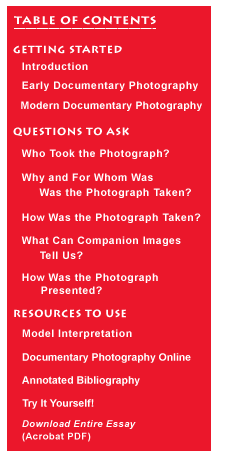|
Frassanito, William. Gettysburg: A Journey in Time (New York,
1975).
This pioneering work on photographs as historical documents details the
many manipulations that photographers made in their chronicle of the aftermath
of the battle of Gettysburg.
Goldberg, Vicki. Photography in Print: Writings from 1816 to the Present
(New York: Simon and Schuster, 1981).
This compilation combines early writings on photography plus some of the
most recent interpretations of the power of the image in contemporary
culture.
Hales, Peter Bacon. Silver Cities: The Photography of American Urbanization,
1839-1915 (Philadelphia: Temple University Press, 1984).
Hales provides the indispensable guide to the history of nineteenth-century
photography and to the creation and reform of urban America. His chapter
on Jacob Riis places both the reformer and his photographs in their respective
cultural contexts. In William Henry Jackson and the Transformation
of the American Landscape (Philadelphia, 1988) Hales shows the critical
role that photography played in westward expansion.
Hurley, F. Jack. Portrait of a Decade: Roy Stryker and the Development
of Documentary Photography in the Thirties (Baton Rouge: Louisiana
University Press, 1972).
This is the first of many books describing the scope of the Farm Security
Administration’s photographic project. Unfortunately there is little
visual analysis of the famous FSA photographs sprinkled throughout the
text.
O’Neal, Hank. A Vision Shared: A Classic Portrait of America
and Its People, 1935-1943 (New York: St. Martin's Press, 1976).
Like Hurley, O’Neal bases his narrative on interviews with FSA photographers
recorded long after they had taken the pictures that he includes in this
lavishly-illustrated book.
Riis, Jacob. How the Other Half Lives: Studies Among the Tenements
of New York (New York: Dover, 1971).
Dover publications reissue of Riis’s classic study of tenement life
in New York’s lower east side gains a new immediacy with the publisher’s
insertion of 100 of Riis’s photographs at key points throughout the
text.
Sontag, Susan. On Photography (New York: Farrar, Straus and Giroux,
1977).
Although more than a quarter century has passed since its publication,
Sontag’s brilliant reverie on the photographic medium remains essential
reading for all students and teachers of photographic history.
Stott, William. Documentary Expression and Thirties America (New
York: Oxford University Press, 1973).
Stott provided one of the first extended definitions of documentary photography
and his formulations continue to influence current scholarship.
Trachtenberg, Alan. America and Lewis Hine: Photographs, 1904-1940
(New York: Aperture, 1977).
Although primarily an exhibit catalogue of Hine’s most memorable
images, this book contains insightful analysis on the formation of the
documentary movement.

|



